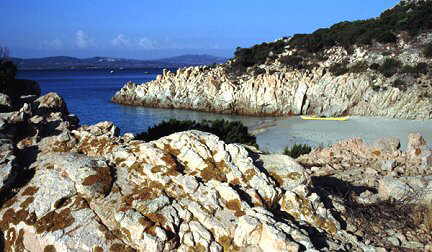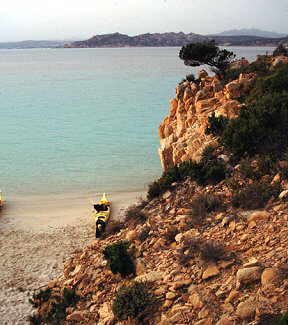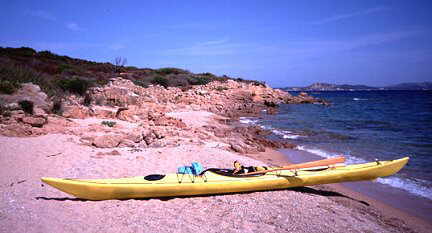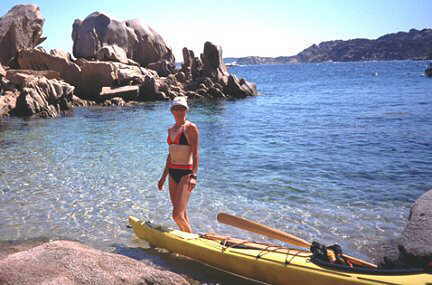
Wendy Killoran
Frenetic waves jostled my kayak in a confounded frenzy. The mistral winds tore over the tepid Mediterranean Sea and waves rebounded in a chaotic mess off the granitic cliffs. But the box of waves I found myself in was created by the continuous wakes of yachts, sailboats and jet skis, which plied the enticing Costa Smeralda in northern Sardinia. There was no predictability to the waves rolling beneath my kayak’s hull. I dug in and plodded on.
The day had started like any typical August day in Sardinia, warm sunshine and a calm turquoise sea. It was my first full day of paddling in this playground of the rich and famous. I was camped at Isuledda Village, a monstrous labyrinth of streets crowded with caravans, tents and bungalows. Here, Sea Kayak Italy has a summer base, offering sea kayaking instruction and guided tours of the Parco Nazionale dell Arcipelago di la Maddalena. I’d rented a Hasle Expedition sea kayak for touring these island gems independently.
Crossing the Golfo Arzachena, I felt like I was crossing a liquid freeway. Pleasure boats of all shapes and sizes tore through the bay, en route to the exotic islands of Caprera, Maddalena and beyond or to the sheltered marina at Cannigione.
Well-timed bursts of paddling, with a moderate tailwind brought me to a secluded sliver of coarse, sandy beach near Forte Cappellini. I paddled through a narrow entrance into a hidden, placid, small bay surrounded by coarse-grained granite rounded into soft, sensuous curves. I’d barely paddled but soon was exploring this beautiful cove, one of dozens I’d explore in my nine days of paddling in this hedonistic locale.
With the wind in my favour, I paddled with blissful energy past carved cliffs and sweeps of sandy, sheltered beaches with colourful umbrellas and ritzy resorts. Not far along I landed in a rock-lined cove that mesmerized me; a spy-hopping whale appeared at the entrance to this deep turquoise hideaway. The sculpted rocks reminded me of nature’s ability to create beauty in such simple lines. I stoked the camp stove on a well-situated rock and I made the first of many espressos. Italians love their coffee and potent espressos are easy to swallow with a sweet dollop of honey, surrounded by radiant sunshine, an irresistible palette of vibrant colours and fanciful rock formations.
Paddling close to shore to avoid the convoy of yachts, which seek out these waters, particularly during the height of the Italian holiday season at the end of August, I gazed at the never ending border of pale granite, carved by eons of wave action and relentless winds. I turned southwards at Capo Ferro, where a lighthouse marks the passage between Isola delle Bisce and Sardinia’s north shore.
Just north of Porto Cervo, a port congested with the largest, fanciest, priciest yachts imaginable, I found a speck of beach to land amongst hundreds of sunbathers. I always looked for respite from the sun by finding a piece of shade. Under a juniper I cut cheese and ate bread. I downed mineral water and bottled juice by the litre. To cool off, I went for refreshing swims in the clear water. Next to my kayak, a small group of teenaged girls, bronzed, beautiful and topless, gallivanted with their boyfriends.
I returned by following the same shoreline. This trip, I would make many day paddles from a base camp with a shower to look forward to eagerly at the end of each day. But the favourable tail winds from earlier had built into a formidable head wind. I attacked this frenzy of waves with gusto. It was tiring. I had always imagined naively that paddling in Sardinia would be relaxing, warm, calm turquoise seas, fantastic sculpted shoreline, quiet coves and gentle breezes to caress the skin with kindness. I’d never imagined a frothy chop of erratic gyrations, an incessant parade of leviathan proportioned boats and sapped energy.
One wave hit my starboard beam with such force, that I yelped as I braced. Those picture postcards never portrayed this mood of the sea. But I should have known better as my research had indicated that winds funnelled between Corsica and Sardinia across the Strait of Bonifacio.
I returned to the sheltered cove of Port Battistone where scuba divers were also exploring the cove. Paddling, bent low into the wind, with resolute conviction, I plodded across Golfo di Arzachena, with a setting sun reflecting a blinding trail of dancing light towards me. A moonlight dinner on the beach ended my first full day of paddling in Sardinia, an island steeped in history, with cultural influences from France, mainland Italy and northern Africa.
I spent several days paddling the islands of Caprera and Maddalena and the nearby shoreline of Sardinia itself, always under intense sunshine. The quiet hours of the morning were so wonderfully suited for kayaking, I kept rising earlier each morning to take advantage of the calm water and absence of boat traffic. I chose to paddle counterclockwise around Caprera, a nature reserve, which forbids wild camping and open fires.
A prominent fort stood austerely silent at Point Rossa. A few yachts and sailboats lay anchored in sheltered bays rimmed by white curves of sand. Near Isola Pecora I found my own private beach. A soft mat of dead sea grass made for a spongy landing. Posidonia oceanica carpets the sea floor in healthy abundance along the east shores of the islands and south shore of Caprera.
It didn’t take long for me to realize that I was privileged to experience Caprera in such an intimate manner, by kayak. The shoreline was stunning. Rounding Point Rossa, the jagged pyramidal peak of Mount Teialone stabbed the clear blue sky. Fairy tale sculptures of granite peeked out from the mountainside and from the startling blue, clear sea. It was nothing shy of Nature in its purest form of grandeur: exceptional beauty in form, texture, colour and sound. In flat areas of crystal clear water, shafts of light beamed into the darkening depths. My senses were seduced into a state of awed, incredulous wonder. The beauty was profound; reverence permeated my soul. This is why I’d come to Sardinia. This was the magic I’d been seeking.

I decided I wanted to have lunch along the east shore, surrounded by these magnificent rocks, dazzling water and brilliant sky, but try as I might, landing spots were non-existent until I reached the northern tip. Avoiding the dense concentration of boats near Point Crucitta, I found a small inlet with a rocky beach barely wide enough for a kayak. I indulged in honey smothered carasau, a crispy, paper-thin bread typical of Sardinia.
Continuing to paddle past rock formations that intrigued the imagination, I ventured onward. But my brief stop was not a filling lunch and I desperately wanted to appease my growling stomach. I’d landed the kayak at a sweltering beach, with rock formations to fire the imagination of even the weakest dreamer. But shade was nowhere to be found. While I stepped over heaps of wild boar turds, and let the prickly branches of the dense bushes scratch my legs, I clambered up to huge boulders with fanciful eroded features. I was in my element, as I bushwhacked myself into a state of bliss under the Sardinian sun’s intense, scorching rays.
The views at the height of the hill were across the bluest blue Passo della Moneta, the passage separating the islands of Caprera and Maddalena. Huge holes that had been eroded into the coarse granite and curvy overhangs made me feel like I was in an extraordinary fairy tale. But, the shoreline was devoid of shade, so I continued paddling southward.
A resort with conical thatched huts rising in rows along the rocky hillside appeared. Wispy sea pines lushly spilled to sea level. I beached my kayak just around the bend on a small crescent of beach and squeezed under a small rock for shade. The scenery behind me resembled Bedrock, the cartoon town from the “The Flinstones,” with giant heaps of scattered rock.
I continued my circumnavigation as the afternoon crawled into late afternoon. Passing by Golfo di Stagnali, I saw the Centro Ricerca Delfini, a scientific research centre for dolphins, tucked into the south shore, but I’d already paddled quite far and still had a considerable distance to cover. The centre is a collaboration with the Parco Nazionale dell Arcipelago di la Maddalena and is located in the protected area of the Cetacean’s Sanctuary of the Mediterranean Sea, established in 1999. This sanctuary covers an area of 90,000 square kilometres and was formed through the co-operation of France, the Principality of Monaco, and Italy. The Maddalena Archipelago is considered a national treasure and within the next few years is hoping for international recognition.
Reaching the tip at Point Fico, I crossed from Caprera towards the now familiar lighthouse that dominates the scenery at Capo D’Orso. I felt hot. The slight breeze was gone. I stopped to drink my warm water, always alert to the high concentration of boat traffic, which funnels through this one-kilometre opening separating Caprera from Sardinia.
I arrived at “Espresso Beach” once again, to indulge in an espresso, a real jolt of caffeine.
Day six was a non-paddling day as I moved my mainland base camp west of Palau, to a narrow peninsula know as Isola dei Gabbiani, where wind surfers and kite surfers slice the water with focussed aggressiveness. I found a place to camp amongst jumbled rocks, sheltered by islets next to a sliver of beach. Sea Kayak Italy transported the kayak for me and showered me with a wealth of information for paddling the nearby islands.
On day seven, at the crack of dawn, I paddled across a calm sea to the island of Spargi in just under an hour. Two sailboats were anchored in Cala Corsara. I decided to paddle along Spargi’s eastern shore as there are more landing beaches there. At Cala Granara, with daylight an amber honey colour, I beached on a perfect crescent of soft, sheltered sand; my very own beach. White lilies blossomed in the dune and orange blobs of lichen painted the nearby rock. The Mediterranean Sea was hushed into a quiet, lulling ebb. This was the best “Espresso Beach” yet, with saw-like mountains piercing the sky to the south on Sardinia as I sipped the potent coffee.
Hugging the eastern shore, I paddled in intensely blue water with the clarity of pure crystal. Pristine beaches backed by scrubby, aromatic Mediterranean junipers and pines appeared around most bends. I crossed over to the island of Budelli on gentle swells that lifted me like a feather floating on air.

At Budelli I landed briefly to stretch my legs. I found a microscopic cove completely out of view, behind rocks as it is forbidden to land on this privately owned island. One of the rocks overlooking my beached kayak resembled a sleeping dragon, like a spell had been cast upon it and turned it into stone. This island is famous for its spiaggia rosa, pink beach, derived from the nearby coral reef which in recent years has lost its pinkish hue due to overuse as the reef has succumbed to coral poachers.
Paddling along Budelli’s eastern shore I entered a natural basin known as Porto Madonna, renowned for mirror calm conditions and stunning hues of aqua blue. Perhaps a hundred boats – yachts, sailboats and Zodiacs – lay anchored in this exotically beautiful piece of Heaven on Earth, backed by a long, curving sandy beach. I wove my way amongst the maze of hulls and anchor lines. Paradise in my mind was lost with such a frenzy of boat activity. I paddled next to a Zodiac on which a topless young lady lay tanning herself; she resembled a mermaid ready to glide into the water.
I crossed over to the island of Razzoli. The scenery continued to become more wild and arid and the rocks more eroded into dream-like shapes. I paddled past a small bay called Ultima Cala according to my very detailed map. Razzoli, the most remote island in the archipelago, seemed to be the ultimate island for raw, natural beauty with the deepest, clear water, the purest, cerulean sky and the most whimsically sculpted rock.
The swells on the west shore of Razzoli were building in height but I was blessed with calm conditions on the exposed shoreline facing the notorious Strait of Bonifacio where 12 kilometres distant I could discern the hazy, undulating outline of the French island of Corsica. Entering Cala Lunga, amongst barren sculptured granitic rock, I found a rocky beach, well protected, where I landed and sat in the shade of what appeared to be a boathouse, which readily provided me with well-appreciated shade.
At the northern tip of Razzoli, the swells were building into waves. Rounding the tip at the Razzoli lighthouse, a view of uninterrupted sea appeared. I paddled well clear of the rocky cliffs as waves rebounded in a crashing crescendo. Near the eastern tip of Razzoli, I met my first group of sea kayakers, a group from Holland and Australia. Their colourful invasion onto my personal beach was a welcome diversion but I soon learned that high winds were predicted and I needed to return to base camp.
I entered into the wondrous Porto Madonna once again, literally dodging boats that seemed to have their compass bearing set for my bow. Several short paddling sprints past gleaming million dollar decks covered by topless tanning beauties got me to safer water. I wondered who might be aboard these luxury boats?
Crossing from Budelli to Spargi, the mistral wind was back and white-capping waves coming towards my starboard beam made for an exhilarating dash. Again I saw a group of sea kayakers, but crossing in the opposite direction. Sea kayaking is still in a state of infancy in Italy, with a wealth of untapped opportunities beckoning.
I rested on a beach along Spargi’s eastern shore, filled with hundreds of people. Soon, like obedient school children, a line of people descended upon a tour boat, partially clearing the beach. The land and sea environments here are fragile, enduring harsh conditions. The national park has set no quotas for visitation, and the invasion of sun worshippers and water lovers is degrading the quality of the experience and ultimately the environment. I had experienced the solitude of an empty beach, and then shared the same beach in the frying sun many hours later with dozens of visitors.
The final paddle to Isola dei Gabbiani was a slog into strong, relentless headwinds. The features I focussed on for dead reckoning navigation crept past me ever so slowly. I was exhausted. The winds seemed to swirl capriciously in unpredictable directions around these island jewels.
On my final paddling day, I rose well before the sun to cross to Spargi on a calm sea. I paddled in predawn greyness and slowly, almost imperceptibly, day awoke in a hazy spell. The sun rose only once I’d beached my kayak on my favourite beach on Spargi. Tasting the sweet warmth of espresso, I savoured the solitude. A few dolphins swam southeast of my cove and the sun emerged as a golden, glowing orb, washing enchanting honey light over this special place.
Yes, I had found “Espresso Beach,” but I’d also found what I’d been looking for: the sun, sand, rock and water had welded into a scene of beauty that stirred my soul.

